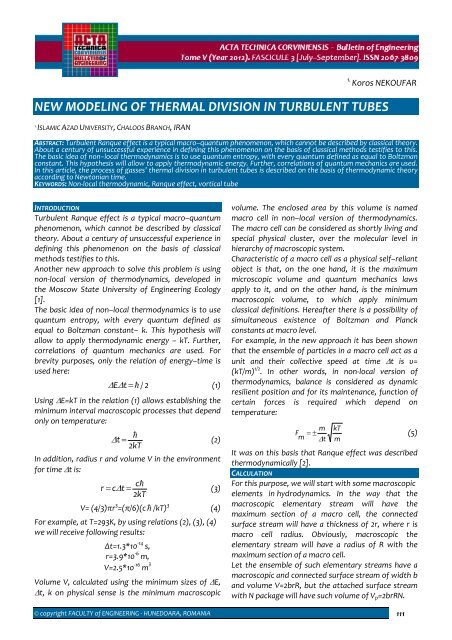1 - Acta Technica Corviniensis
1 - Acta Technica Corviniensis
1 - Acta Technica Corviniensis
You also want an ePaper? Increase the reach of your titles
YUMPU automatically turns print PDFs into web optimized ePapers that Google loves.
1.Koros NEKOUFARNEW MODELING OF THERMAL DIVISION IN TURBULENT TUBES1.ISLAMIC AZAD UNIVERSITY, CHALOOS BRANCH, IRANABSTRACT: Turbulent Ranque effect is a typical macro–quantum phenomenon, which cannot be described by classical theory.About a century of unsuccessful experience in defining this phenomenon on the basis of classical methods testifies to this.The basic idea of non–local thermodynamics is to use quantum entropy, with every quantum defined as equal to Boltzmanconstant. This hypothesis will allow to apply thermodynamic energy. Further, correlations of quantum mechanics are used.In this article, the process of gasses’ thermal division in turbulent tubes is described on the basis of thermodynamic theoryaccording to Newtonian time.KEYWORDS: Non‐local thermodynamic, Ranque effect, vortical tubeINTRODUCTIONTurbulent Ranque effect is a typical macro–quantumphenomenon, which cannot be described by classicaltheory. About a century of unsuccessful experience indefining this phenomenon on the basis of classicalmethods testifies to this.Another new approach to solve this problem is usingnon‐local version of thermodynamics, developed inthe Moscow State University of Engineering Ecology[1].The basic idea of non–local thermodynamics is to usequantum entropy, with every quantum defined asequal to Boltzman constant– k. This hypothesis willallow to apply thermodynamic energy – kT. Further,correlations of quantum mechanics are used. Forbrevity purposes, only the relation of energy–time isused here:Δ EΔt= h / 2(1)Using ΔЕ=kT in the relation (1) allows establishing theminimum interval macroscopic processes that dependonly on temperature:hΔ t =(2)2kTIn addition, radius r and volume V in the environmentfor time Δt is:chr = cΔ t =(3)2kTV= (4/3)πr 3 =(π/6)(c h /kT) 3 (4)For example, at T=293K, by using relations (2), (3), (4)we will receive following results:Δt=1.3*10 ‐14 s,r=3.9*10 ‐6 m,V=2.5*10 ‐16 m 3Volume V, calculated using the minimum sizes of ΔЕ,Δt, k on physical sense is the minimum macroscopicvolume. The enclosed area by this volume is namedmacro cell in non–local version of thermodynamics.The macro cell can be considered as shortly living andspecial physical cluster, over the molecular level inhierarchy of macroscopic system.Characteristic of a macro cell as a physical self–reliantobject is that, on the one hand, it is the maximummicroscopic volume and quantum mechanics lawsapply to it, and on the other hand, is the minimummacroscopic volume, to which apply minimumclassical definitions. Hereafter there is a possibility ofsimultaneous existence of Boltzman and Planckconstants at macro level.For example, in the new approach it has been shownthat the ensemble of particles in a macro cell act as aunit and their collective speed at time Δt is υ=(kT/m) 1/2 . In other words, in non‐local version ofthermodynamics, balance is considered as dynamicresilient position and for its maintenance, function ofcertain forces is required which depend ontemperature:Fmm kT= ±(5)ΔtmIt was on this basis that Ranque effect was describedthermodynamically [2].CALCULATIONFor this purpose, we will start with some macroscopicelements in hydrodynamics. In the way that themacroscopic elementary stream will have themaximum section of a macro cell, the connectedsurface stream will have a thickness of 2r, where r ismacro cell radius. Obviously, macroscopic theelementary stream will have a radius of R with themaximum section of a macro cell.Let the ensemble of such elementary streams have amacroscopic and connected surface stream of width band volume V=2brR, but the attached surface streamwith N package will have such volume of V p =2brRN.© copyright FACULTY of ENGINEERING ‐ HUNEDOARA, ROMANIA 111
















